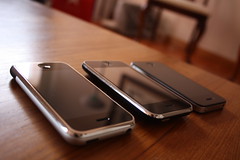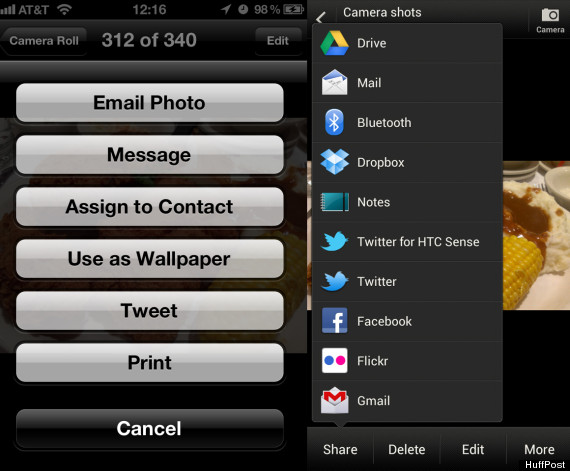
iPhone 2g, iPhone 3GS, iPhone 4 (Photo credit: reticulating)
For about five years now, the question for smartphone buyers has been a classic either/or: “Android or iPhone?” Answering that question is more difficult than ever, thanks to large advances in Android, as well as the emergence of a third viable option: Microsoft’s beautiful Windows Phone OS.
This week, we’ll attempt to break down your three options, looking at each operating system’s greatest strengths and weaknesses. Which one you choose should depend largely on how you use your phone.
For the first part of this comparison, let’s look at the iPhone and the iOS operating system. The most oft-repeated (and spot-on) description of the iPhone and its operating system is that Apple knows what you want and gives it to you and doesn’t let you change it; you can’t really alter or customize the experience because — well, why would you want to?
Frankly, you would want to. There’s a lot that’s perfect about iOS, but there’s also a lot it could learn from Android and Windows Phone. Here’s where it sparkles over its competitors and where it could use work:
Strengths :-
- Games And Apps: Apple doesn’t just have the most apps in its app store; it also has the best apps. This is especially true for gaming: Gameplay on the iPhone is smoother than on any other smartphone I’ve tried.
- Camera: The camera on the iPhone 4S trumps any other smartphone camera I’ve tried. The HTC One X comes close, but for high-quality photography day or night, the iPhone 4S is your best bet.
- Easy To Use: The iPhone still has a simple interface that makes it a good buy for a first-time smartphone user. I think Windows Phone is a little easier to use — the larger icons help, especially for older buyers with declining eyesight — but the iPhone is still idiot-proof, from initial use, to navigating the phone, to the use of each individual app. The always-available Apple support team of Geniuses also helps.
- iMessage: The iPhone is the most popular single smartphone in America, and with iMessage, texting any other iPhone is essentially free. Rather than counting against your monthly text message, any message sent over iMessage counts a minimal amount against your data plan.
- Device Speed: Forget processors — the iPhone is still, screen-to-screen, the fastest smartphone experience that is available. Apps and games load quickly and without stutter, and the touchscreen is always responsive to your touch, something that no Android phone can say quite yet. It’s a satisfying experience and a big reason why the iPhone maintains its slick appearance.
Weaknesses -:
- Maps/Navigation: We’re still waiting on voice navigation — spoken turn-by-turn directions — on the Maps app on the iPhone. You can download other apps (for free) with Voice Navigation, but when you click on an address in an email or on a website to get directions, you’ll be taken into Apple’s Maps, not your GPS app of choice. Frustrating.
- Facebook: Uploading photos to Facebook — and Instagram, Google+, Dropbox and more, but let’s focus on the world’s largest social network — is harder than it should be on the iPhone. When you take a photo on Android or Windows Phone, there is an option to upload it to Facebook and even tag your friends straight from the camera. On the iPhone, you have to go into the Facebook app and manually upload it. Apps just don’t communicate with each other very well on the iPhone. For example, here is what I can do with a photo on the HTC One X versus what I can do with a photo on the iPhone 4S:

- Homescreen: The iPhone’s homescreen, and your options for what can be shown on it, is the most rigid and limited of the three major operating systems. When you unlock your iPhone’s screen, you’re going to be looking at your static rows of icons and nothing else. On Android and Windows Phone, you have the option to have “widgets” or “live tiles,” respectively, that can give you a preview of your new mail, the current weather, top headlines, Facebook and Twitter updates, etc, without having to open any individual app.
- Mail: Email on the iPhone is disappointing. Email reliably arrives slower on my iPhone than it does on Android devices, and searching through your archives for old messages is harder on the iPhone.
- 3G: Word is that Verizon salespeople are now pushing prospective iPhone buyers over to 4G Android devices, because the iPhone 4S runs on the slower 3G network rather than the newer, faster 4G network. Some writers are upset about this, but they really shouldn’t be: The fact is that, to a consumer who just wants a phone that can make calls, send text messages and surf the Internet, the difference between operating systems matters less than the difference between 3G and 4G speeds. According to a 2012 study from PCWorld, 3G smartphones’ (like the iPhone 4S) data speeds were around 1.05 megabytes per second on the download. On Verizon’s 4G LTE network, that number rose to 7.35 megabytes per second. It’s a speed advantage that is tangible when you are surfing the web or downloading apps on your smartphone.
So Who Should Buy The iPhone?
Buying an iPhone 4S is like walking into a pizza shop and getting a slice of pepperoni pie. It’s a safe choice that won’t let you down, but if you start to think about it, you might end up wondering what else you might have gotten.
The iPhone 4S is easily the best smartphone option for those who spend a lot of time playing games on their phones or who download a lot of apps to fill out their phone’s functions. For those who use their phone as their primary camera, the iPhone 4S is also the best choice. Given how easy it is to use, and Apple’s famously accessible “Geniuses” at its retail stores, I would also recommend it for first-time smartphone buyers who don’t feel comfortable or confident in their ability to navigate the system. If you anticipate having lots of questions or needing assistance, Apple’s help desk is phenomenal.
For those using their smartphone as an email, text message, Internet-browsing-portal, I would hold off on buying the iPhone until it upgrades to 4G LTE (probably in October), especially if you live in a large city, where 4G coverage will arrive first. You just might feel awfully silly with a 3G phone two years from now, considering the booming speeds and multibillion dollar expansion in 4G LTE networks that the four major U.S. carriers are going through right now. If you’re committed to iOS and the iPhone, wait five months to get a new phone.
Source :- http://www.huffingtonpost.com
Related articles
- iPhone 4S: Forward Into Ubiquity! (allthingsd.com)









